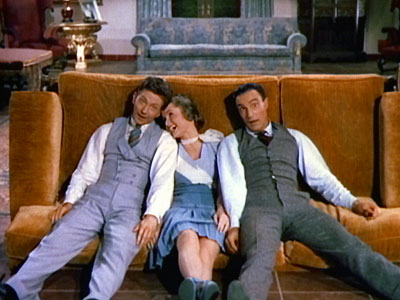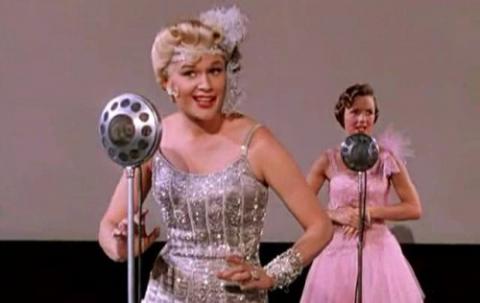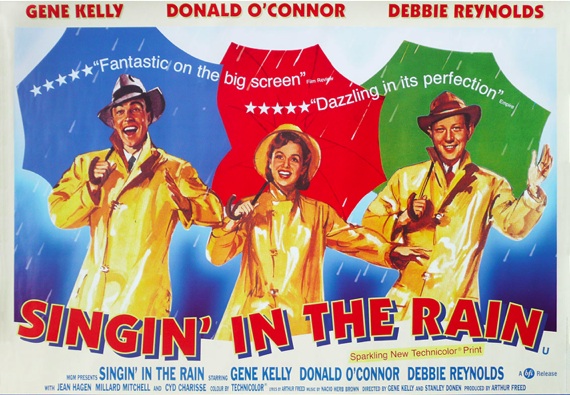Singin’ In The Rain (dir. Stanley Donan & Gene Kelly)
Though my first love in cinema will always be horror films, I have such an affection for musicals. The glitzy costumes. The aggressively perky and optimistic characters. The song and dance that always seems spontaneous, and from the heart. This odd, and utterly fabricated world, is always both the complete antithesis, and the perfect compliment to the grimy underbelly of film in which I typically dwell. In fact, you will even find an umbrella just for Gene Kelly nestled in my tattoos amongst the zombies and vampires.
While the genre can whisk you away to foreign lands, and domestic bliss, it is also historically problematic when it comes it its representations of women, and gender in general. Though the men are singing and dancing, they are always men’s men, expressing their gender through ruggedness and emotional unavailability. The women are often window dressing, and pawns in the plot, rather than autonomous people who have actual emotions and ambitions. Singin’ In The Rain suffers from some of the same issues that many musicals have with their treatment of genders, but it does have a surprisingly progressive character as well.
First, we must cover the unfortunate representation of women in the film. Even within the context of a film released in 1952, but portraying the invention of the talking pictures in 1927, it has some nearly inexcusable moments. The worst of which is the “Beautiful Girls” number. The title of this song, crooned by a matinee idol, is just the beginning of my issues with it. The song follows a man describing all of the latest fashions for a modern woman as we see each of these outfits modeled by woman in dioramas to showcase the fashion as it would be worn in the world. Each of the women is frozen in place, to mimic a lifeless, soulless, mannequin, with varying degrees of success in not fidgeting. This transformation from people to objects is enough to put many people into a gender misrepresentation-spin, but my issues with the sequence does not stop there. The culmination of this sequence is when the modern “girl’s” life hits its highest point: the wedding dress. The music soars, and it is clear that all of her outfits and activities have built towards this final costume. When this gown is revealed all of the women come to life, and then surround the singer to frame him as he belts out those last lyrics. Clearly this sequence in particular is communicating the end all, be all of a woman’s life is her wedding. After that there is no more soaring musical numbers, and no more fancy outfits to be had. While this sequence does have major problems ideologically, it is unfortunately not too far from how women are portrayed today as well. If you browse any modern newsstand you will still see these framed female bodies, each frozen in their own dioramas of life with the perfectly corresponding outfit. You will also see the great white wedding dress being sold as the most important object a woman will ever buy. This is why I hesitate to be too critical of the film–we are not too far from these representations. It by no means validates these portrayals, but it does put them in perspective.

Somehow, in the sea of women (all of them far past the age of being called “girl), swaying next to the crooner is our heroine, Kathy Selden (Debbie Reynolds). Kathy is by far one of my favorite, and the best characterized, women in musicals of this era.
We first meet Kathy when Don Lockwood (Gene Kelly) jumps in to her car to escape a throng of overzealous fans. With Kathy driving herself we instantly associate her with independence. And unlike the pursing fans, Kathy can act logically and contain herself.
Inevitably Kathy and Don fall in love, and spend the rest of film ensuring that they are able to stay together while growing their careers.
The thing that I find unique about Kathy’s character is that she is so balanced. She is never a caricature. She is able to keep up with Don and his buddy Cosmo (Donald O’Connor), but she never veers into becoming “one of the guys” by sacrificing her femininity just to match them in comedic timing. She also dances and sings along with them, but never as a partner who is put there to make Don look better. And it seems no matter what else is thrown at her, she remains herself. Being so self aware and content is not always shown for characters in musicals. Frequently the women are shown as aggressive career women who sacrifice themselves for their careers (Majorie Reynolds in Holiday Inn) or women who are put there just to be romanced by the main character. Kathy is strong enough to not only know who she is, but also can be true to herself and pursue both her personal life and her career.

It is this intersection of career and love which makes the final scene in the film heart wrenching. At a film premier Kathy is called upon to continue providing the voice for the shrieking silent film star Lina (Jean Hagen), at the expense of her own burgeoning career. Singing for Lina again would mean giving up any hope for singing herself, but both the head of the studio and Don are threatening her with ending her career if she refuses. She begrudgingly agrees to help them, but tells Don that she can’t love him if he asks her to sacrifice her career for his. Though their love is so strong, Kathy knows that what Don is asking her to do is selfish, and goes against what her desires are. She is clearly pained by the decision, which is refreshing to see. She wants both love and career, and knows that she should not be forced to choose between the two. In the end, Don and Cosmo expose Lina for what she is, and Kathy’s career and love life are saved. I have no objections to the fact that Kathy is saved by the men of the film. Conversely, I celebrate that Don needed to find a way to save Kathy’s career in order to win her back. He could have just let her run away, and then attempt to woo her back after the fact, but in order to win her heart again he needed to prove to her that he took her career as seriously as his own. Had he not prioritized her career, their relationship would be ultimately doomed.

With Kathy’s level-headed portrayal in Singin’ In The Rain it is easy for me to long for other women characters in modern film to be like her. It is her self-assuredness, and strength without stubbornness that make her believable and admirable. And any woman who can effortlessly keep up with Gene Kelly should be considered heroic.
———-
Deirdre Crimmins lives in Boston with her husband and two black cats. She wrote her Master’s thesis on George Romero and works too much.




